At one time, Willats was a fairly common surname in Berkshire. My 4x great grandfather John Yard Willats (1782-1855), was a Mayor of Reading, a maltster, and a partner with William & Charles Blandy in the Mill Lane Brewery. His name has appeared in this publication before in an article by my cousin Les Hooper (Willats, Yard, & Hooper: Three Reading Families, June 2007). This article focuses on John Yard’s cousin (once removed), Thomas Willats (1762-1852).
In 1685 John Yard’s 2x great grandfather, Moses Willats, mealman of Reading, married Hannah Cartwright, the miller’s daughter at Caversham. Hannah’s brothers Charles and Edward took over the mill after the death of their father Thomas in 1690, but both Cartwright brothers died young with no male heirs, so when Edward wrote his will in 1729 he passed his property to various nieces and nephews. To his sister Hannah’s son Thomas Willats (1698-1741) he bequeathed
All those my Mills called Caversham Mills and the dwelling house thereunto belonging wherein I now dwell and all that my Lock called Caversham Lock And all outhouses buildings lands Eyotts Waters Weares Floodgates Sluices Fishings Profits Advantages and Appurtenances whatsoever.”
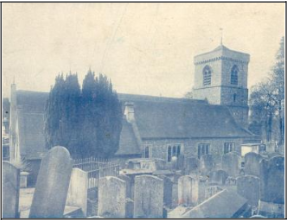
Thomas Willats had married Elizabeth Simmonds in 1720 and between 1722 and 1739 they had seven children that survived to adulthood. Thomas died in 1741, and his wife Elizabeth in 1771. They are buried together under a double headstone in the churchyard of St. Peter, Caversham.
Thomas Willats the Elder
Their eldest son was another Thomas, (1722-1786) who followed his father as miller at Caversham. He married Elizabeth Toovey in 1751, which brought a connection to the Powell family of Englefield, one member of which was wealthy bachelor Thomas Powell of Kidmore End.
Thomas Willats and his wife Elizabeth had five daughters in quick succession, and then in 1762, their final child and only son was born – Thomas (1762-1852), our subject. He was baptised at St. Peter Caversham and Thomas Powell was named his godfather. Thomas Powell died in 1768, aged 50, never having married or produced a legitimate heir. He remembered his godson in his will:
To my Godson Thomas Willats the younger Son of Thomas Willats the Elder of Caversham aforesaid Mealman the sum of Three hundred pounds when he shall attain his age of twenty one years
Thomas Willats the Younger
So at age 24 Thomas, our subject, came home from Oxford to become head of his family and follow in his father’s footsteps. Two years later he married Elizabeth Laura Littlehales, daughter of Baker John Littlehales of Moulsey, Surrey (see Debrett’s) and in 1792 at age 30, served as High Sheriff of Oxfordshire, 20 years after his father.
He seems to have been a bookish man, subscribing to books of poetry and travel, and being remembered in his mother-in-law Maria Littlehales’ 1794 will:
I desire that my Furniture & all other effects not bequeathed in this Will may be sold without any Auction to Thomas Willats Esquire my son in Law — I desire may be paid Eight Hundred pounds due to him upon my Bond one year after my decease, likewise Fifty Books to be chosen by him out of my Collection
Thomas was also a religious man. His children were all baptised at St. Peter, Caversham, but he attended St. Giles in Reading where he was a follower of the evangelical Rev. William Bromley Cadogan, naming his first son Thomas Cadogan in his honour. After Rev. Cadogan’s death, Thomas published a pamphlet in 1798 in defence of Rev. Cadogan and criticizing the new minister of St. Giles, An apology for the Church of Christ and the Church of England; with a vindication of the doctrines of the late Hon. and Rev. W. Bromley Cadogan. Thomas was also one of the largest subscribers when the breakaway church St. Mary’s Chapel on Castle street, Reading was founded (Berkshire Record Office D/P175/5/1).
Thomas and Laura Elizabeth had seven children – four boys and three girls. The eldest, Thomas Cadogan (1789-1826), was sent to Cambridge in 1807, destined for the Church. The second, Peter John (1793-1875) began his career in the army in 1809. But even in 1803 it was clear that Thomas was in serious financial difficulties. His mother Elizabeth wrote in her will that year of “the anxiety I have to deliver my dear Son Thomas Willats from every pecuniary embarrassment he may have at the time of my decease.”
It was hard for me to understand the origin of these “embarrassments.” No doubt Thomas had spent much on his children’s education, and on becoming High Sheriff for a year. Had he also “inherited” debt from his father along with the mansion house and farms?
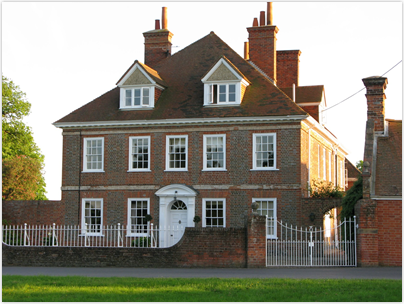
In 1809 he leased Kidmore House and much of the estate to James Winch Grave and moved his family to Henley. In 1812, he signed an indenture giving his son Thomas Cadogan the “moiety” of the estate he would normally have inherited only after Thomas’s death. The following year, his son Thomas Cadogan brought a case to the Court of Chancery (C13/2797/49 Willats v Willats) requesting the estate be divided between himself and his siblings as per his grandfather’s 1783 will. It seems likely that these actions were taken in the hope that the estate might be protected from his father’s creditors.
Thomas Willats, prisoner
However, nothing that Thomas did could satisfy the creditors. In 1817 he was committed to the King’s Bench debtor’s prison where he remained for the next seventeen years, moving 16 times “within the Rules” but finally residing within the walls.
In 1820, while in prison, he put his property up for auction. But he was not released after selling his estate. Instead, the following year he was the defendant in two separate Chancery cases arising from the sale. One of the purchasers charged that Thomas had not turned over the title deeds to a purchased lot (C13/1429/39 Maitland v Willats). And, more seriously, Ely Stott complained (in C13/1429/49) that Thomas and his several adult children had signed indentures starting in 1814 which mortgaged the Kidmore Estate to Stott as security for loans totalling approximately £18000. Since the terms for repayment had not been met, Stott was asking the court to establish his right to the estate.
It was very exciting to find this document, but instead of answering my questions it just created new ones. How could Thomas have received such large loans from Stott and still not be able to pay his creditors? Did the Court of Chancery decide in favour of Stott in 1821? I already knew that problems with ownership persisted up to 25 years later.
While a prisoner of the King’s Bench, Thomas was able to live with his family in rented accommodation “within the rules” after paying a suitable fee to the prison governor. His wife died there in 1825. His eldest son Thomas Cadogan, who had been appointed Rector of Hadley, Cambridgeshire in 1822, was living with his father when he died in 1826. Both mother and son are buried at St. George the Martyr, Southwark. A happier occasion was the marriage of Thomas’s youngest daughter Elizabeth Lydia to William Darnton in 1830, also at St. George the Martyr, a church “within the rules”of the King’s Bench, so that Thomas was able to attend and sign as witness.
Thomas Willats spent 17 years in debtor’s prison, despite owning an estate at Kidmore End, Oxfordshire. One of the most interesting documents I found regarding his legal troubles was the Chancery case brought by Ely Stott in 1821 (C13/1429/49), when Thomas was in the King’s Bench prison.
It can be a struggle to understand Chancery court documents and I have occasionally found clearer descriptions in the law journals available online. So I searched archive.org for “Stott +Willatts” and found “A Report of the Judgment in Dew v Clark and Clark” by Sir John Nicholl. This case was very relevant to my research, but I could not easily have found it by searching TNA Discovery, since Thomas Willats was only one of many witnesses who were not name-indexed.
The case was brought by Stott’s daughter, Mrs Charlotte Dew, against Thomas and Valentine Clark, the administrators and main beneficiaries of Stott’s will. Mrs. Dew claimed the will was written while her father was of unsound mind. Judge Nicholl’s report was a summary of the case as it stood in 1826. The mention of Thomas Willats was brief; it included a description of the initial meeting in July of 1813 between Thomas (the deponent) and Stott (the deceased) after a church service in London.
…. the deceased said, ‘No, your name is Willatts, is it not?’ the deponent acknowledged his name, but said he had not the pleasure of knowing him; the deceased then said, that he must have some conversation with the deponent, and he led the deponent on towards his house in Hart Street, Bloomsbury; where the deponent being urged to it by the deceased, spent the rest of the day with him. On their way as they walked, the deceased told the deponent, that he knew he was a distressed man; but added, that he would clear the deponent of all his difficulties, and in the hope of that relief, the deponent spent the day with the deceased, and, on the following morning, again called on the deceased by appointment, and made the deceased acquainted with his situation. The deceased immediately advanced him a sum of 4,500l. to the deponent, and thus his knowledge of the deceased arose, and his intimacy with him began.” …
The behaviour of both men was so odd – I had to know more! So I ordered PROB/37/553 Dew v Clark and Clark (and then DEL 2/21 Clark and Clark v Dew) at the National Archives.
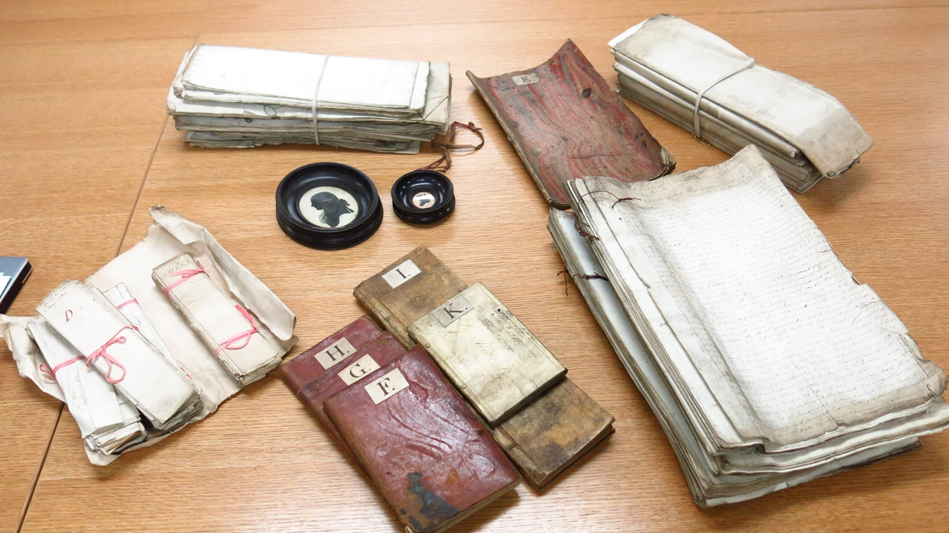
These documents were almost overwhelming – Nicholl’s report described it as “perhaps one of the greatest masses of evidence that was ever presented to this Court.” There were over a hundred pages of depositions and exhibits by Stott’s family and friends relating to his state of mind over a period of years, including twenty-one letters – some 13,000 words – written by Thomas Willats between 1813 and 1823.
Thomas Willats’ letters
I tackled the letters first. In many ways they are typical personal letters; they mention the weather, ask after mutual acquaintances, and relate snippets of Willats family news, such as visits to the Jessons in Staffordshire, and from his brother-in-law Sir Edward Littlehales and family. Quite often Thomas refers to his own ill health.
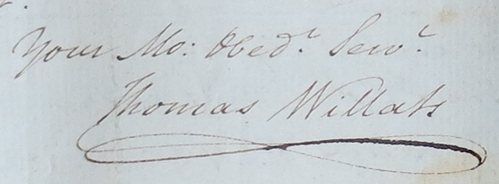
In the early letters Thomas often wrote paragraphs of a strictly religious nature, referring to sin, Satan, prayer, and divine blessings. He considered his friendship with Stott was “formed upon christian principle.” So perhaps it is only surprising to our modern ears to read Thomas’s comments on his youngest son’s illness. Bendall Toovey Willats (1796-1832) was suffering from a “nervous complaint” in September 1813.
I cannot but hope that many blessings will flow out of this trial, who knows but God may be preparing him to declare to sinners the glad tidings of salvation by preaching the gospel of Christ, or who knows but something which may drop from his lips may be blessed of God to the conversion of others of my family, I think it is our duty to look at afflictions in this point of view.
However, I also noted that at least half of the letters to Stott contain some sort of excuse – for a late reply or a neglected visit, and especially in the summer of 1814, putting off a visit by Stott to Henley. I began to wonder whether Thomas’s friendship with Stott was sincere. And as Thomas’s financial difficulties increased in 1816 and 1817 his letters to Stott became more business-like.
Caught in a lie
In a letter Thomas wrote to Stott’s lawyers in June 1820, he explains why his debts were not cleared after the supposed sale of his estate.
Perhaps as you attended the sale of the estates yesterday, you might suppose they were bona fide sold; but the fact is, that in consequence of the biddings being so much below what we consider to be the worth of the property, all were bought in, except the last lot, which was purchased by Col. Maitland,
The last of Thomas’s letters was written in 1823, after Stott’s death. It is an (unsuccessful) begging letter sent from the King’s Bench prison to Thomas Clark, Stott’s nephew and beneficiary. In it, Thomas Willats first blames his own father for his current situation.
I began my career of difficulties in 1786, which was the year my father died; the fact was, he left me only a legacy of £50, in cash, with the Oxfordshire estates …; he moreover left my Mother executrix to his Will, so that I was obliged to pay her interest every year for all the stock of the farm he occupied, and which I took upon myself at his death; he also had neglected for many years the necessary repairs of the different farms, the consequence was that the tenants would not take fresh leases unless I would engage to put them in proper repair, I, therefore, was compelled to borrow a sum of money for this purpose, and this was the beginning of all my embarrassments,
Then he blames Ely Stott:
Perhaps you are not aware of it, but Mr. Stott was principally the cause of my coming into this neighbourhood, as he often declared he would remove all my pecuniary embarrassments, and kept pressing me to have more money
Finally he blames his family, first for extravagant spending,
my family, finding I had met with such an extraordinary friend in Mr. Stott, they launched out, and ran up bills in so many directions,
and then for offending Ely Stott during a visit, so that
… he declared to them, “that they should pinch in another way;” and when he returned to town, he thought of an expedient that would effectually check them, and sent for me to consult me upon it; but it was an unfortunate expedient for me, as prior to this, he had not hinted to me the subject of the mortgage to secure the sums he had advanced, but he now insisted upon it, and of course I could not, as an honest man, object to it,
Thomas was able to carry on for a time, thanks to family support and his ability to acquire almost everything on credit.
After some time, Mrs. Willats wrote to her Brother, [Sir Edward Littlehales] and laid our distressed case before him, and as he had an income of £8000 a year; he agreed to allow her £300 a year, upon condition we would move from Henley, into a small house, in the neighbourhood of London, this was agreed to, and as soon as we could leave Henley, we took a house at Somers’ Town, for one year, but in the course of that year there were bills run up unknown to me, (as I spent much of my time with my Mother, who then lived at Reading,)
Much of Thomas’s explanation has the ring of truth. But I have caught Thomas in a lie: I know that Thomas’s mother Elizabeth Toovey died in 1812, several years before Thomas met Ely Stott and the family moved to Somers Town. Are there any other lies that I cannot detect?
What the depositions reveal
Next I turned to the witness depositions. These were meant to reveal Stott’s state of mind and behaviour, but Thomas’s answers also reveal much about himself.
Thomas stated that he frequently stayed at Stott’s house, for days and sometimes weeks at a time, spending between five and six months with him during the first two years of their friendship. It was Stott’s practice every evening to “expound a portion of the scriptures” to his servants, and to pray
“extempore, and in prayer, or that which he substituted for prayer, he was loud, vehement, and extravagant; his prayers were mere rhapsody, but he had a notion that they were excellent and effectual; … he frequently expressed his astonishment that they did not produce a greater effect upon the Deponent; he wondered that the Deponent was not, as he said, moved to tears”
A few months after their friendship began, Stott introduced the subject of his daughter Charlotte, living elsewhere at the time, whom he described as “the special property of Satan, and the peculiar victim of evil” and “most abandoned in conduct, and depraved in heart and mind.” When Thomas finally met Charlotte he found her to be “the reverse of all that her Father had described her to be.” He tried to bring about a reconciliation between father and daughter, but eventually gave up, finding that it was useless to reason with Stott, since he became
”very speedily, quite furious upon the subject … there was a wildness in his eye, and a degree of excitement about him, that in the Deponent’s judgment, plainly indicated a disordered mind”.
Many witnesses testified to Stott’s extreme behaviour. When questioned about Stott’s treatment of his servants, Thomas related the following incident.
On one occasion, when the Deponent was staying at the Deceased’s house … the Deceased desired to have his boots, the servant boy brought them … the Deceased looked at them, and said, now take them away again, the boy did so, and the Deceased then followed him down stairs, and the Deponent heard him flogging the boy unmercifully; the cries of the boy were distressing, but the Deponent did not dare go to his relief. The Deponent is a small man, and the Deceased was very powerful, and his passion ungovernable;
Then Thomas went on to relate an incident that occurred in May 1816, after he and Stott were no longer on friendly terms. Thomas had continued to call occasionally to ask after Stott’s second wife Susan Terry, whom he had known before her marriage. She had been ill but was improving when Stott unexpectedly sent for Thomas early one morning. Thomas went to Stott’s house
and found him in his parlour; the Deponent said, how shocked he was to hear of Mrs. Stott’s death. The Deceased replied, “Yes, I killed her.” The Deponent asked him what he could possibly mean, the Deceased said again, that he had killed her; I gave her too strong a dose, (he said,) it did not occur to me that she was in such a weak state. The Deceased spoke this with extraordinary coolness, and almost immediately afterwards began talking upon other subjects, as though no such event, as the death of his Wife, had occurred at all. The Deponent remembers the Deceased’s conduct upon that occasion well; it was most remarkable; when he first knew the Deceased, and for some time, he looked upon the Deceased as a very eccentric man; but afterwards, the Deponent considered that there must be, and he has no doubt that there was, disorder in his mind.
Thomas Willats was clearly shocked by Stott’s behaviour, but not necessarily by the cause of Mrs. Stott’s death. Ely Stott was a “doctor” whose medical practice was based on the use of electricity. He had become interested in this new field around 1780, not long after its first use in England in 1767, and his practice had flourished. But Thomas deposed that Stott held
extravagant notions as to what he could accomplish by means of electricity; he seriously declared, and seemed to be fully convinced, and was, as the Deponent believes, that “a supernatural power attended him” in the use of electricity.
There was no inquiry into Mrs. Stott’s death and in fact, Stott married a third wife in 1818. Would it have been different if the circumstances around the death of the first Mrs. Stott, shortly after Charlotte’s birth, had been known? A witness told the court
The Deponent perfectly well recollects the circumstance of the deceased being accused, at the time of his wife’s death, of recommending her washing in cold water shortly after her confinement, and that it terminated fatally.
So it is clear from Thomas’s own statements that he spent nearly six months living with a man whom he considered “a very passionate man, and extremely self-opinionated; much that was repulsive, and something of what was extravagant, might be attributed to that, particularly as he was uneducated and illiterate”. But Thomas has been described as a “small man.” He was in financial difficulties and his whole estate had been mortgaged to Stott.
I think that despite all his difficulties, and perhaps some poor decisions, Thomas retained the respect of his family. I have no direct evidence for this, only two references to him in family wills. First, Thomas’s brother-in-law Sir Edward Baker Baker (formerly Sir Edward Baker Littlehales) made provisions in his 1822 will for annuities to Thomas’s wife and daughters, and for the maintenance of his son Bendall Toovey, who needed care all his life, as well as bequests of money to each of Thomas’s children.
The second is the 1822 will of Thomas’s son-in-law Edward Sellon, married to his daughter Laura. Edward died aged 30 after only five years of marriage and in his short poignant will he leaves a personal item to each of his close family members – his Bible, a favourite book, a ring, a brooch – and to Thomas Willats, a wish for his freedom.
to my dear father-in-law Mr. Willats to my dear kind friend Free.
After his release from the King’s Bench in 1834, Thomas continued to live in Surrey. He seems to have maintained good relations with his family, witnessing his daughter Juliana’s marriage to Daniel Burton in 1835 and subscribing in 1847 to his grandson Edward Sellon’s first book “Herbert Brakespeare.” He died at age 90 at the home of his widowed daughter Laura (Sellon) Booty. Fifteen years later, Laura and her sister Elizabeth Lydia Darnton finally administered their father’s estate. Thomas left no will and less than £20.
